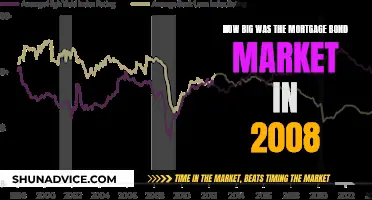
The mortgage industry is undergoing a digital revolution, and it's about time. The traditional mortgage process has long been an arduous journey for borrowers, characterised by piles of paperwork, manual errors, and long waiting times. However, digital mortgage solutions are now streamlining the borrower experience, offering a faster, more efficient, and personalised journey. This shift is driven by technological advancements, the rise of digital lenders, and the post-pandemic remote work era. By leveraging automation, digital platforms, and innovative tools, lenders are simplifying the mortgage process, reducing the time and cost involved, and providing borrowers with a smoother, more transparent experience.
| Characteristics | Values |
|---|---|
| Customer Experience | Enhanced customer experience |
| Technology | Use of AI, ML, analytics, RPA, online tools, automation, etc. |
| Speed | Faster loan disbursement |
| Cost | Cost savings for the consumer |
| Competition | Differentiation from traditional brokers |
| Efficiency | Reduced manual effort, errors, and costs |
| Convenience | Anytime/anywhere experience |
| Simplicity | Simpler, faster, and more accessible |
| Data | Improved data visibility |
What You'll Learn

Digital mortgage platforms improve the borrower experience
The traditional mortgage process is often slow, costly, and cumbersome, with long queues, high commissions, and extensive paperwork. Digital mortgage platforms offer a streamlined and improved borrower experience by addressing these pain points.
Firstly, digital mortgage platforms simplify the process by offering online tools for remote loan completion. This means borrowers can complete their mortgage applications from the comfort of their homes, without the need for in-person interactions. This remote capability became particularly crucial during the COVID-19 pandemic, which accelerated the shift towards digital solutions.
Secondly, digital platforms provide a more personalized and modern experience. Well-designed interfaces allow borrowers to independently manage various aspects of their mortgage application, such as accessing loan information, making payments, communicating with lenders, and organizing documentation. This self-service option saves time for both borrowers and loan officers, as borrowers can proceed at their own pace without relying on the constant availability of loan officers.
Additionally, digital mortgage platforms leverage technology to enhance the speed and accuracy of the process. For example, automation reduces manual errors and streamlines document verification, which is often a bottleneck in the traditional process due to its manual and slow nature. Features such as online calculators, AI-based assistants, and seamless data transfer between different systems further contribute to a faster and more efficient experience for borrowers.
Furthermore, digitalization can lead to cost savings for lenders, which can then be passed down to consumers in the form of more competitive rates. By using technology to quickly match borrowers with multiple investors, digital mortgage lenders can offer borrowers access to a wider range of loan options. This increased accessibility and speed of information empower borrowers to make faster and more informed decisions.
Freedom Mortgage: A Giant in the Industry
You may want to see also

Streamlining the application process
The mortgage application process can be a daunting and exhausting experience for buyers, especially first-time buyers. The traditional process is often categorized by rising costs, minimal technology, and an overwhelming amount of paperwork.
Digital mortgage processes aim to streamline the application process by leveraging technology to minimize human intervention and maximize efficiency. This involves offering online tools for remote loan completion, such as digital platforms that allow borrowers to handle various aspects of their mortgage application, including accessing loan information, making payments, communicating with lenders, and managing documentation.
By adopting digital solutions at every step of the loan processing lifecycle, lenders can streamline the application process. This includes using online forms for faster data collection, automated systems for quicker decision-making, and digital closing solutions. For example, digital platforms can utilize document intelligence to automate the verification process, reducing the time and cost involved in manual verification.
Additionally, digitalization can enhance the borrower experience by providing a more personalized, modern interface. Borrowers can move at their own pace without constantly relying on loan officers for assistance. This saves time for both parties and empowers borrowers to manage their applications more independently.
Full-scale digitalization is key to a successful digital transformation in the mortgage industry. By keeping the entire process, from form-filling to approval, on the same platform, lenders can improve efficiency, reduce manual errors, and enhance user satisfaction.
Bush's Legacy: Lowering Mortgage Standards, Raising Risks
You may want to see also

Reducing the time to close
The digital mortgage process has significantly reduced the time to close, enhancing the overall borrower experience. This is achieved through several means, including the use of online tools and platforms that allow borrowers to complete the mortgage process remotely and at their own pace. By digitalizing the entire value chain, from form-filling to approval, companies can streamline the process, making it faster and more efficient.
One of the key benefits of digital mortgages is the reduction of manual interventions and paper-based processes. This minimizes human errors and the need for constant back-and-forth communication with loan officers. For example, digital platforms enable borrowers to manage their applications, access loan information, make payments, and handle documentation without relying on in-person meetings. This not only saves time but also provides borrowers with a more personalized and modern experience.
Additionally, digital mortgage platforms leverage automation and advanced technologies such as AI, machine learning, and analytics. These technologies ensure complete digitization, a paperless process, and quicker loan disbursement. The use of online forms and automated underwriting systems further accelerate decision-making and streamline the closing process.
The adoption of remote online notarizations (RONs) is another factor contributing to reduced closing times. While legislation has been a hurdle in the past, the increasing acceptance of RONs across states is streamlining the digital mortgage process. This enables borrowers to complete the entire process remotely, without the need for physical document submissions or in-person meetings.
Furthermore, digital mortgage lenders can quickly match borrowers with multiple investors through technology. This facilitates competitive rates for customers, as well as faster and more efficient closing processes. By digitalizing and automating various steps, lenders can enhance operational efficiency, reduce bottlenecks, and provide borrowers with timely updates and faster service.
Rent vs. Mortgage: How Close Should They Be?
You may want to see also

Automating the verification process
The mortgage process can be an exhausting experience for buyers, with a large volume of paperwork and manual form-filling required. This can lead to delays, human errors and miscommunications. Automating the verification process can help to streamline the borrower experience by reducing the need for manual work and improving speed and accuracy.
Digital platforms can provide a more personalised, modern experience for borrowers, allowing them to handle all aspects of their mortgage application, including accessing loan information, making payments, communicating with lenders and managing documentation. This saves time for both the borrower and the loan officer. By allowing borrowers to manage their applications without needing to meet one-on-one with a loan officer, digital platforms can provide flexibility and reduce anxiety.
Automation can also help to minimise human intervention and errors, and enhance user satisfaction. For example, CoreLogic’s Digital Mortgage Platform integrates with leading loan origination systems to ensure a seamless and accelerated transfer of data and documents. This can help to reduce the time taken to close a loan, putting buyers at ease and preventing them from being swayed by competing firms.
Full-scale digitalization can help to improve processing, underwriting and closing results, reducing the time and cost involved and providing a smoother experience for customers. This can be achieved by keeping the entire process, from form-filling to approval, on the same platform. This ensures a smooth workflow and prevents employees from ending up with more work due to digitalization.
The Evolution of the Mortgage Market: A Historical Perspective
You may want to see also

Using technology to match borrowers with investors
The digital mortgage industry is leveraging technology to streamline the borrower experience and improve operational efficiency. One key advantage of digital mortgage processes is the ability to quickly match borrowers with investors using technology. This enhances the overall customer experience by offering competitive rates and seamless online purchasing.
Digital mortgage lenders, such as Rocket Mortgage and SoFi, have brought the mortgage lending process online, making it more accessible and efficient for borrowers. These lenders use technology to match borrowers with multiple investors, providing customers with more options and competitive rates. This real-time matching process is facilitated by artificial intelligence (AI), machine learning (ML), analytics, and robotic process automation solutions (RPA). The use of technology minimizes human intervention, simplifies the process, and reduces the time and effort required for both the lender and the borrower.
For example, digital mortgage platforms may utilize algorithms that analyze a borrower's credit score, financial stability, and income to match them with investors or lenders who meet their specific criteria. This automated matching process eliminates the need for manual paperwork and speeds up the time-consuming task of finding compatible investors. Additionally, digital mortgage lenders can offer flexible loan options and faster closing times due to their specialization and less regulatory burden.
The use of technology in matching borrowers with investors also benefits investors and lenders. Digital platforms provide lenders with access to a larger pool of potential borrowers, increasing their reach and enabling them to connect with borrowers who meet their investment criteria. This efficient matching process reduces the time and resources invested in manual processes, resulting in cost savings for lenders, which can then be passed on to borrowers in the form of competitive rates.
Furthermore, digital mortgage platforms offer enhanced data security and transparency throughout the loan process. Electronic services, such as e-signatures, document notarization, and secure data storage, ensure that sensitive information is protected and easily accessible. This streamlines the borrowing and investing experience, providing borrowers with peace of mind and investors with confidence in the integrity of the process.
Why Your Mortgage Payment Increased and What to Do
You may want to see also
Frequently asked questions
A digital mortgage platform improves the borrower experience by bridging the gap between borrowers and lenders, reducing manual errors, and enhancing user satisfaction. It allows borrowers to handle all aspects of their mortgage application process, including accessing information about their loans, making accurate payments, communicating seamlessly with their lenders, and managing documentation with ease.
Technology helps simplify the mortgage process by offering online tools to complete mortgage loans remotely, minimising human intervention, and providing quicker loan disbursement. It also enables businesses to produce, transfer, and store mortgage details without the need for a paper trail, a loan officer, or a closing agent.
Digital mortgage lenders can offer more competitive rates by quickly matching borrowers with multiple investors through automation. They also provide a user-friendly product design, radical transparency, zero commissions, and on-demand service.
Digitalisation improves the mortgage process by providing a more streamlined and personalised experience for borrowers, reducing the time taken to close a loan, and increasing customer satisfaction. It also helps to drive down costs for the consumer and improve employee productivity by reducing mundane tasks.







